September 11 attacks
The terrorist attacks of September 11, 2001 (9/11 [nʌɪn ɪˈlɛvn̩]) were four coordinated airplane hijackings followed by suicide bombings of iconic civilian and military buildings in the United States of America. According to findings by American security authorities, the attacks were planned by the Islamist terrorist network Al-Qaeda under the leadership of Osama bin Laden and perpetrated by 19 of its members, including 15 nationals of Saudi Arabia.
On the morning of September 11, terrorists hijacked four passenger planes in three groups of five and one group of four. First, at 8:46 a.m. local time, American Airlines Flight 11 was maneuvered into the north tower of the twin towers of the World Trade Center (WTC) in New York City. The subsequent impact of United Airlines Flight 175 into the south tower of the Twin Towers at 9:03 a.m. had already been broadcast live on TV worldwide. Due to significant structural damage to the buildings, both skyscrapers collapsed completely over the course of the following hour and a half. Numerous surrounding buildings were destroyed or severely damaged by debris. In the late afternoon of September 11, WTC 7, which had been damaged by the collapse of the North Tower, finally collapsed.
At 9:37 a.m., a hijacking group piloted American Airlines Flight 77 into the Pentagon, the headquarters of the U.S. Department of Defense near Washington, D.C. The last hijacked United Airlines Flight 93 was brought down by the hijackers' pilot near Shanksville, Pennsylvania, at 10:03 a.m. after fighting with passengers, and was the only one of the four hijacked planes to miss its intended target. The attacks, classified as mass terrorist killings, claimed 2996 lives from 92 countries. Among the victims were eleven German citizens and two Swiss nationals. Austria had no dead to mourn. Numerous memorials were created in commemoration, including the National September 11 Memorial and Museum, the Pentagon Memorial and the Flight 93 National Memorial.
Immediately after the attacks, US President George W. Bush proclaimed a "War on Terror". In the course of the military operation Enduring Freedom, the war in Afghanistan began on October 7, 2001, with the aim of overthrowing the Taliban government that had ruled since 1996 and fighting Al-Qaeda. Al-Qaeda founder Osama bin Laden first claimed responsibility for the 9/11 attacks in 2004, and a U.S. special forces unit liquidated bin Laden as part of Operation Neptune Spear on May 2, 2011. The U.S. government also referenced the attacks to justify the 2003 Iraq War, despite doubts from numerous NATO allies. According to a study by the IPPNW, well over a million people have been killed in the "war on terror".
The state of emergency declared in the US on 14 September 2001 is still in force. In the wake of the September 11 attacks, governments around the world enacted new counterterrorism laws, often caught between individual liberty and collective security.
Strokes
Procedure
→ Main article: Course of the terrorist attacks on 11 September 2001
| Time | Event |
| 08:46 | Flight AA 11 hits WTC 1 (North Tower) |
| 09:03 | Flight UA 175 hits WTC 2 (South Tower) |
| 09:37 | Flight AA 77 flies into the Pentagon |
| 09:59 | WTC 2 collapses |
| 10:03 | Flight UA 93 crashes near Shanksville |
| 10:28 | WTC 1 collapses |
| 17:20 | WTC 7 collapses |
World Trade Center
live footage from 9:00 a.m. to 10:40 a.m.
Expiry September 11, 2001
Graphics & Illustrations
According to the 9/11 Commission's investigative report, at 8:14 a.m. local time on September 11, 2001, five members of the radical Islamic terrorist network Al Qaeda hijacked the commercial flight American Airlines Flight 11 from Boston to Los Angeles. At 8:19 a.m., they turned off the transponder of the Boeing 767-223ER with a total of 92 people on board. As a result, the passenger plane was only detected by primary radar. Flight altitude, speed and identification could no longer be automatically assigned by the air traffic controllers. Also beginning at 8:19 a.m., two flight attendants notified the Federal Aviation Administration (FAA) and their carrier of the hijack in progress. At 8:37 a.m., the FAA notified North American Aerospace Defense Command (NORAD), the military air defense command, of the hijacking and requested that fighter jets be allowed to ascend. Initially, there was confusion among the military's air traffic controllers in charge, as NORAD was orchestrating the large-scale Vigilant Guardian counterterrorism exercise taking place at the same time, which also involved aircraft hijackings. After receiving assurances from the FAA that the hijacking was not part of the exercise, two F-15s then took off from Otis Air Force Base at 8:46 a.m. However, the pilots were not given any targeting information and were initially directed into military-controlled airspace off the coast of Long Island. They remained in this corridor until 9:13 a.m.
At 8:46 a.m., AA11 crashed into the northern facade of the North Tower (WTC 1) of the World Trade Center at an airspeed of about 750 km/h. The impact was reported live from New York City at 8:48 a.m. by television stations around the world. Television stations around the world reported on the impact live from the scene in New York City from 8:48 a.m. onwards. It was initially believed to be an accident and people in the adjacent South Tower (WTC 2) were urged to remain calm and stay at work. According to NIST's final report, between the 93rd and 99th floors, the body of the plane severed a total of 35 of WTC 1's 236 exterior columns and six of 47 interior columns, and removed fireproofing on 43 of those columns. All three stairwells collapsed, severing elevator connections above the 60th floor. An estimated 15% of the 38,000 gallons of jet fuel on board went up in a fireball, with about half leaking unburned into the building. The remaining fuel dispersed in fireballs through the elevator shafts, blowing out doors and walls on several floors and shattering numerous ground-floor lobby windows. Immediately afterward, countless concerned people called 911.
Between 8:42 and 8:46, United Airlines Flight 175, also departing Boston for Los Angeles, was hijacked by another group of five of the terrorists. At 9:03 a.m., the Boeing 767-200, with 65 people aboard, flew into the south facade of the South Tower. The aircraft impact occurred at 870 mph between the 77th and 85th floors of WTC 2, severing 33 of 236 exterior piers, including the southwest corner pier, and ten of 47 interior piers, and stripping the fireproofing on 39 of those interior piers. Here, too, around 15% of the 34,500 litres of kerosene on board evaporated immediately on impact, with at least half leaking unburnt into the building. With the second impact within a short period of time, US authorities and witnesses realized that obviously targeted terrorist attacks had been carried out. From then on, evacuations of the entire WTC complex including the annexes WTC 3, WTC 4, WTC 5, WTC 6 and WTC 7 were announced. Nonetheless, FDNY firefighters and hundreds of other first responders struggled to reach people trapped above the impact sites.
The South Tower collapsed completely 56 minutes after the 9:59 a.m. impact. Debris from the collapsing South Tower destroyed WTC 3, which served as a hotel, and WTC 4, which housed the world's largest commodity futures exchange (NYMEX) and the world's largest trading floor for commodity futures in gold, silver, platinum, copper, aluminum, oil, gas, cotton, sugar, cocoa and orange juice concentrate at the time, was almost completely buried by the South Tower. The 11-meter-high St. Nicholas Greek Orthodox Church, which stood in the immediate vicinity of the South Tower, was completely destroyed. The neighbouring Deutsche Bank Building was so badly damaged that it had to be demolished floor by floor until 2011.
At 10:28 a.m., 102 minutes after the impact of Flight AA11, the North Tower also collapsed completely. The collapse of the North Tower caused severe damage to the World Financial Center buildings to the west due to ejected debris and almost completely destroyed WTC 5 and WTC 6. WTC 7, which had already been evacuated shortly after UA 175 struck, was 186 meters tall, sustained damage to its south facade, and caught fire on several floors. Finally, WTC 7 also collapsed completely in the late afternoon at 17:20. The collapse of WTC 7 also caused significant damage to surrounding buildings. The adjacent 32-story New York Telephone Building subsequently had to be restored at a cost of $1.4 billion. The City University of New York's Fiterman Hall (30 West Broadway) to the north was so badly damaged that it had to be demolished.
American Airlines Flight 77 was scheduled to fly from Washington Dulles International Airport to Los Angeles. The Boeing 757-223ER passenger plane was hijacked between 8:51 a.m. and 8:54 a.m. by five Saudi Arabian al Qaeda members. The plane hit the Pentagon near Washington, D.C. at 9:37 a.m., punching a breach through three sections of the building's west side. The exploded jet fuel caused a major fire. This caused the affected façade to collapse at approximately 10:10 a.m. At 9:42 a.m., FAA headquarters ordered all passenger aircraft in U.S. airspace to land at the nearest airport.
The last to be boarded was United Airlines Flight 93 at 9:28 a.m. by a group of four, which was scheduled to fly from Newark, near New York, to San Francisco with 44 people aboard. The Boeing 757-222 changed course at 9:32 a.m. heading east. At 9:55 a.m., one of the hijackers entered the frequency of a Ronald Reagan Airport navigation system into the onboard computer to navigate toward Washington, D.C. The hijackers then changed course. Air traffic control confirmed the course change. The target of the attack was later believed to be the White House, the Capitol, or the U.S. president's country residence at Camp David. In a June 2002 interview with Al-Jazeera editor Yosri Fouda, al-Qaeda member Ramzi Binalshib said the fourth plane was intended to hit the Capitol.
Some passengers on this flight learned of the attacks on the WTC during boarding calls and attempted to enter the cockpit and subdue the hijackers starting at 9:57 am. As a result, the pilot of the hijackers brought the plane down at 10:03. It crashed near Shanksville, about 100 kilometers east of Pittsburgh. NORAD did not learn of the hijacking of this flight until 10:15 a.m. The Northeast Air Defense Sector (NEADS) in Rome, New York, did not receive orders to intercept and possibly shoot down hijacked aircraft until about 10:30 a.m.
Rescue missions
The coordination of rescue operations was originally to be managed by the New York City Office of Emergency Management (OEM), which had been located on the 23rd floor of WTC 7 opposite the Twin Towers since 1999. However, since WTC 7 was completely evacuated immediately after the plane strikes, this task fell unceremoniously to the New York City Fire Department (FDNY) and the New York Police Department (NYPD). They were assisted by the Port Authority of New York Police Department (PAPD), which continued to be responsible for the security of all World Trade Center buildings despite the lease of the Twin Towers to Silverstein Properties in July 2001. Due to the OEM failure, FDNY, NYPD, and PAPD had to operate uncoordinated and autonomously from each other with different communication systems during rescue operations.
Rescue efforts began immediately after the impact of American Airlines Flight 11 into the North Tower of the World Trade Center. Joseph W. Pfeifer, operations officer of the 1st Battalion of the FDNY, had directly observed the approach and impact of the Boeing 767 from close range and reported it to the operations center. Pfeifer was accompanied on the morning of September 11 by the two French filmmakers Jules and Gédéon Naudet. The rare film footage showing the impact of Flight AA11 into the North Tower was taken on this occasion.
PAPD ordered a complete evacuation of the North Tower just one minute after the impact. Six minutes after impact, four fire units were already on the scene, setting up a makeshift command post in the devastated lobby of the North Tower. As rescue efforts began, United Airlines Flight 175 crashed into the South Tower. Initially, firefighters planned to evacuate the 25,000 to 50,000 people believed to be in the towers, rescue injured people and extinguish fires around the impact site. On the ground, however, incident commanders realized there was no hope of controlling the fire on the upper floors and the decision was made to focus on evacuating the towers. Since all of the 99 elevators in each tower had failed, it would have taken too long to haul the heavy firefighting equipment up the stairwells to the affected floors above the 77th floor. Each tower had two stairwells leading continuously from the ground floor to the 110th floor. A third stairwell in each case extended from the 6th floor to the 107th floor. Each of the passage doors from the offices to the stairwells was designed to be opened manually in spite of fire. The doors to the rooftops, on the other hand, were sealed off. There was no evacuation and rescue concept for rescuing injured people from the roof by helicopter, as the roofs were so obstructed by technical installations that it was impossible to land. Emergency drills had failed to inform World Trade Center employees that the roof doors were locked and that there was no evacuation plan via the roof platforms. Numerous people who were above the impact zones tried to escape via the roof, but were faced with locked doors. Consequently, they became stuck on the floors just below the roof as fire and thick smoke ate ever higher through the upper floors of the Twin Towers.
While the FDNY and the PAPD concentrated solely on evacuating the buildings at the beginning of the rescue work, the NYPD first cordoned off the immediate and then the wider surroundings of the WTC, then supported the evacuation of the towers and began to determine the course of the attacks. Through three NYPD helicopters, police command received information about the situation in the towers, which, however, did not reach the fire department's command.
After a short time, the emergency lines were completely overloaded by thousands of emergency calls. Numerous emergency calls came from people in the Twin Towers who were trapped on the upper floors and all escape routes were cut off from them. An FDNY incident commander decided to set up a temporary command and assembly point in the lobby of the Marriott Hotel (WTC 3). The advantage of the location was that the main entrance to the hotel faced West Street, where nearly all fire and rescue vehicles were assembled. In addition, a side entrance from the hotel provided direct access to the South Tower. Falling debris and falling people made access through the main entrance of the South Tower too dangerous for emergency personnel. Numerous people were also evacuated via the entrances from WTC 5 and WTC 6 on Vesey Street. At 9:59 a.m., the South Tower collapsed within ten seconds, killing all 630 employees and rescue workers in the building, as well as many people on the streets. The collapse created a violent storm and a cloud of dust and debris. Falling debris destroyed WTC 3 and the FDNY's temporary command post inside.
After the collapse of the South Tower, most incident commanders withdrew rescue personnel from the North Tower. However, even 30 minutes after the collapse of the South Tower, not all of the incident commanders who were on their rescue missions in the windowless stairwells of the North Tower had learned of the collapse of the neighboring tower. At 10:28 a.m., the North Tower also collapsed, burying all 1355 people trapped on the upper floors, numerous first responders and an unknown number of victims on the ground around the collapsing skyscraper. In a nearly intact stairwell near the bottom of the North Tower, 12 firefighters, three PAPD officers, and three civilians survived the collapse.
About 87 percent of the 17,400 people inside the World Trade Center buildings at the time of the initial plane impact were able to save themselves or were evacuated by emergency services. Of the total of about 1,000 rescue workers, the FDNY lost 343 firefighters, the PAPD lost 37 personnel and the NYPD lost 23 police officers.
The forensic search of genetically usable remains of the victims was carried out on a site of the former Fresh Kills construction waste dump in Staten Island, N.Y., as part of the World Trade Center Recovery Operation that existed until July 2002. All debris and remains of the collapsed buildings, steel beams, and more than 1,300 wrecked cars had previously been transported to the island stored off Manhattan. Out of 4257 human remains filtered out, 300 victims could be identified.
Some 65,000 emergency workers were involved in the rescue and cleanup efforts at Ground Zero, which lasted until May 2002. They and others were exposed to varying degrees to the numerous toxic pollutants in the air they breathed as a result of the collapse of the Twin Towers. The extent and management of the long-term health consequences have been the subject of increased debate in the USA since around 2005. In November 2010, the City of New York approved a USD 625 million aid package for ten thousand victims. In addition, US President Barack Obama signed the James Zadroga 9/11 Health and Compensation Act, which was signed into law on January 2, 2011, and which today provides care for almost 75,000 victims. That includes the roughly 65,000 emergency workers at Ground Zero, as well as another 10,000 survivors and victims. About half (37,305) of those enrolled in the health program have at least one disease associated with 9/11. Most suffer from respiratory and gastrointestinal illnesses (32,291, including 27,613 responders) and mental illnesses such as post-traumatic stress disorder (12,500, including 9,465 responders). Cancer, meanwhile, ranks third with 5441 cases (of which 4692 were among emergency personnel). In July 2019, Ground Zero-related causes of death already killed the FDNY's 200th firefighter.
fatalities and injuries
According to official figures, 2,996 people lost their lives in the terrorist attacks on 11 September. Among the victims were eleven German citizens and two Swiss nationals. Austria had no dead to mourn. 372 fatalities from 92 countries were not American citizens. The number of people acutely injured on September 11 is estimated at more than 6,000. More than 3,200 children lost one or both parents in the attacks. Numerous memorials have been created to commemorate the victims of September 11, including the National September 11 Memorial and Museum, the Pentagon Memorial, and the Flight 93 National Memorial.
As a result of the airplane strikes on the twin towers of the World Trade Center in New York, a total of 2,763 people died. Among them were 127 passengers, 20 crew members and 10 hijackers of the two planes. Witnesses who resided as guests at the Marriott Hotel between the Towers Towers and declassified photos from NIST document that human parts littered West Street and surrounding streets immediately after the planes hit. In the Twin Towers, 2128 people died, most of whom worked in offices above and around the impact site. Cantor Fitzgerald, an investment bank located on the 101st to 105th floors in WTC 1, lost 658 employees on September 11. Consulting firm Marsh Inc. had its offices between the 93rd and 100th floors of WTC 1 and was right in the center of the impact of Flight AA11, which crashed between the 94th and 98th floors. 295 employees and 63 freelancers of the consulting firm died in the attacks. In WTC 2, the insurance company AON, located on the 92nd and 98th to 105th floors, lost 175 employees. Before the towers collapsed, about 200 people plunged to their deaths. They were cut off from escape routes on the upper floors and jumped to escape unbearable heat, life-threatening burns or toxic smoke. Furthermore, 343 firefighters, 37 New York Port Authority officials, 23 police officers and 75 passersby were killed. The New York Institute of Forensic Sciences worked for years to genetically identify and match body parts of the victims. In October 2019, the 1645th victim was identified. There is still no forensically usable trace of 40 percent, or 1108 of 2753 people killed in New York.
189 people died in the Pentagon attack, including 125 government employees, 53 airplane passengers, 6 crew members, and 5 hijackers. 44 people, including 33 passengers, 7 crew members and 4 hijackers, lost their lives at Shanksville.
| Flight | Occupants (†) | Accident site | † at the scene of the accident | Total |
| American Airlines Flight 11 | 92 | WTC | 2606 | 2763 |
| American Airlines Flight 77 | 64 | Pentagon | 125 | 189 |
| United Airlines Flight 93 | 44 | Shanksville | - | 44 |
| Total | 265 | 2731 | 2996 |
To compensate victims and survivors of the attack, the September 11th Victim Compensation Fund was created shortly after September 11 with so-called Liberty Bonds. The US federal government authorizes the fund, headed by Kenneth Feinberg, to pay out a maximum of 7.375 billion US dollars from US government funds. In exchange for an individually determined compensation amount, victims and survivors give their consent not to sue the two airlines American Airlines and United Airlines.
Assassin
→ Main article: al-Qaida
Immediately after the impact of American Airlines Flight 11 and United Airlines Flight 175 into the twin towers of the World Trade Center, media representatives, politicians, and intelligence and terrorism experts speculated about Osama bin Laden and the radical Islamic terrorist organization Al-Qaeda, which he founded, as the authors of the attacks.
Fifteen of the 19 hijackers of September 11, 2001, identified by the FBI shortly after the attacks were citizens of Saudi Arabia, two were from the United Arab Emirates, and one pilot each was from Egypt and Lebanon. In 2002, the FBI released biographical details of the hijackers. All of the assassins came from wealthy, respectable, rather secular families and enjoyed an education that qualified them to study abroad. Only there did they seek and find contacts with radical Islamic preachers who propagated jihad against the West. Their ideology included the belief in a Jewish world conspiracy, the image of an imperialist West colonizing and continually humiliating the Islamic world, and a hatred of the worldwide social injustice produced by globalization.
The three alleged suicide pilots, Mohammed Atta, Ziad Jarrah and Marwan al-Shehhi, who have been described as key figures by the 9/11 Commission, were enrolled as students at the Technical University of Hamburg-Harburg and the Hamburg University of Applied Sciences at the time of the attacks. Marwan al-Shehhi was a "scholarship holder of the armed forces", according to the embassy of the United Arab Emirates in Bonn. Atta, al-Sheehi and other allies had lived at 54 Marienstrasse in Hamburg-Harburg since the 1990s and became known as radical Salafist-oriented members of the Hamburg terror cell. They regularly visited the al-Quds mosque in Hamburg-St. Georg. At the end of January 1999, Mohammed Atta founded an Islam AG under the name Mohamed El-Amir at the TU Hamburg.
In 1996, first Mohammed Atta and then his Hamburg comrades-in-arms declared their willingness to die a martyr's death. A suicide attack in the West was ruled out for the time being. The decision to carry out an attack in Western countries was made, according to speculation, after the first contact with an al-Qaida member in autumn 1998. According to witnesses, they had been planning the attacks since spring 1999, which were ultimately carried out on 11 September 2001. In November 1999, Atta, al-Shehhi, Jerrah and Ramzi Binalshibh, also a member of the Hamburg terror cell, traveled to Afghanistan and met bin Laden in Kandahar in December. Bin Laden selected them for the attacks because of their technical and linguistic abilities and prepared the selected assassins ideologically and technically in his training camps to carry out the attacks. In this training camp they announced their last will and testament on January 18, 2000, and then flew back to Hamburg.
In the spring, Ramzi Binalshibh, who had been designated as a terrorist pilot, was denied a visa to enter the United States by various authorities. Bin Laden then designated his Saudi Arabian compatriot Hani Handschur as a replacement, since Handschur was already studying in the United States. In May 2000, Atta, Al-Shehhi, and Jarrah, also designated as pilots, received their entry visas to the United States. Immediately after arriving in the U.S. in June 2000, Atta and Al-Shehhi attended flight school in Florida and eventually obtained their commercial pilot licenses in December 2000, which authorized them to operate aircraft with a gross weight of 5.7 tons and carry a maximum of 9 passengers. Ziad Jarrah also attended the same flight school in Florida at the same time. In the meantime, however, he returned to Germany to his girlfriend living in Bochum and attended a flight school in the nearby town of Mülheim an der Ruhr in order to complete further training hours for the acquisition of a private pilot's license. Following the licensing sessions, the assassins began training on a simulator for passenger aircraft. Jarrah and Handschur booked practice flights in small aircraft in the New York and Washington, D.C., areas to learn flight routes, air traffic, and topography. Numerous reconnaissance flights to Los Angeles and Las Vegas followed. Atta received more detailed instructions from Bin Laden at a meeting with Binalshibh in Europe in the spring of 2001 and was the only one to learn the attack targets as well. From then on, Atta coordinated all the assassins involved, who Bin Laden had selected and who had entered the USA since April 2001. Atta is also said to have set September 11 as the date for the attack and the Capitol as the target instead of the White House, which was more difficult to reach.
On September 13, 2001, the FBI released the names of all 19 hijackers as determined from passenger lists and seat numbers booked with clear names. On September 27, 2001, the FBI released photographs and personal information of the 19 hijackers, including alternate name spellings because some names had been confused with those of living persons.
Assassins of September 11, 2001
- American Airlines Flight 11: Mohammed Atta (pilot), Abdulaziz al-Omari, Satam al Suquami, Wail al Shehri, Waleed al Sherhri
- United Airlines Flight175: Marwan al-Shehhi (Pilot), Fayez Banihammad, Mohand al Shehri, Ahmed al Ghamdi, Hamza al Ghamdi
- American Airlines Flight 77: Hani Handschur (Pilot), Khalid al Mihdhar, Majid Moqed, Nawaf al Hazmi, Salem al Hazmi
- United Airlines Flight 93: Ziad Jarrah (pilot), Saeed al Ghamdi, Ahmed al Nami, Ahmed al Haznawi.
By 2008, 13 of the 19 hijackers had been identified with DNA analysis, nine of them through exclusion procedures and four through comparison samples. The remains of six of the ten hijackers in New York City could not be individually matched. In addition, the passport of hijacker Satam al-Suqami was found a few blocks from the World Trade Center shortly after the impact. A passerby had picked it up and handed it to an NYPD detective shortly before the twin towers of the WTC collapsed.
On September 28, 2001, the FBI released a four-page handwritten letter, copies of which were found in three places, and attributed it to the pilots of three of the four hijacked flights. Atta's copy was found in a late-checked travel bag at Boston Airport. This will, combined with a "suicide bomber primer," read something like, "Open your heart, welcome death in the name of God ... for you are but a brief moment away from the good, eternal life in the company of martyrs." Abdelghani Mzoudi confirmed the authenticity of the document in October 2001.
FBI antiterrorism expert Dale Watson testified in 2002 to the 19 assassins' ties to Al Qaeda and Bin Laden. The FBI continued its investigation for years with about 7,000 of 11,000 employees under the PENTTBOM designation.
Client
The US government accused Osama bin Laden (1957-2011) of having initiated, commissioned and co-financed the attacks on the basis of evidence gathered by its intelligence services. The latter hailed the attacks as the will of Allah, but initially denied any involvement. In November 2001, the U.S. Army found a videotape in Jalalabad in which bin Laden spoke with members of his group about the attack planning, named some of the hijackers, praised them, and stated that he had not told them the attack targets until they were in the United States and did not expect the WTC buildings to collapse completely. Possible translation errors were checked by US media: They found nine names of hijackers involved and other evidence of prior knowledge of the attacks in bin Laden's statements.
In March 2002, Ramzi Binalshibb and Khalid Sheikh Mohammed described in detail to Al-Jazeera editor Yosri Fouda in Karachi the approximately ten-year preparation of the attacks on behalf of Bin Laden. Based on intercepted telephone conversations, money transfers and witness statements, the US considers Chalid and Mohammed Atef to be the main planners of the attacks. Muhammad Haidar Zammar is believed to be the recruiter for the assassins. Bin Laden selected the later bombers in 1999, helped finance the attack plan and ordered the later hijackers to fly to the US in November 1999.
On 1 November 2004, three days before the re-election of George W. Bush, Bin Laden addressed the US population and explained when and why he had come up with the idea of the attacks and that more of this kind would follow if the US did not change its policy. In other video and taped messages, he made clear his planning for the attacks. He and his most important co-planners always cited US support for Israel and its policy towards the Palestinians as the main motive.
Unclear role of Saudi Arabia
→ Main article: 9/11 Commission#Unexplained role of Saudi Arabia
Fifteen of the 19 attackers on 11 September 2001 came from Saudi Arabia. However, the role of Saudi Arabia, the Saudi royal family and members of the Saudi intelligence service in the terrorist attacks regarding possible complicity and support of Al-Qaeda remains unclear and is still part of serious diplomatic conflicts of interest and civil claims for compensation by survivors of the victims of September 11.
The Saudi Arabian government in Riyadh has repeatedly denied suspicions that it supported the al-Qaeda bombers. In July 2016, the U.S. government released previously redacted pages of a congressional report that proved or suggested contacts between some of the assassins and the Saudi government. For example, Zacarias Moussaoui, who was convicted as a terrorist, testified under oath that Saudi members of the royal family, including Bandar ibn Sultan, had donated to al-Qaeda and helped finance the September 11 attacks. Declassified information from the redacted portion of the 9/11 Commission Report shows that two of the hijackers received $130,000 from Bandar's bank account.
Until the fall of 2016, Saudi Arabia and members of the Saudi royal family enjoyed broad immunity in the United States. This changed in September 2016, when the US Congress overrode President Barack Obama's veto of the Justice Against Sponsors of Terrorism Act (JASTA) and allowed civil lawsuits against Saudi Arabia related to 9/11. Without naming Saudi Arabia, the law was created specifically to allow lawsuits against Saudi Arabia by bereaved families. This created significant tensions in foreign relations between the U.S. and Saudi Arabia. For example, in the run-up to the passage of the law, Saudi Arabia threatened the US with the sale of $750 billion in US government bonds and other financial restrictions.
On March 20, 2017, 1,500 injured survivors and 850 family members of 9/11 victims filed a lawsuit against the Kingdom of Saudi Arabia. The plaintiffs allege that the government of Saudi Arabia had prior knowledge that some of its officials and employees were al-Qaeda operatives or sympathizers. The complaint alleged that Saudi Arabia "knowingly provided material support and resources to the Al Qaeda terrorist organization and facilitated the September 11 attacks."
A federal court finally overruled Saudi Arabia's sovereign immunity in March 2018. Civil lawsuits against Saudi Arabia related to 9/11 have been allowed since then. The court thus definitively rejected Saudi Arabia's request not to allow lawsuits against it. The government of the Arab state fears recourse payments in the billions if involvement in the crime can be verified by the courts.
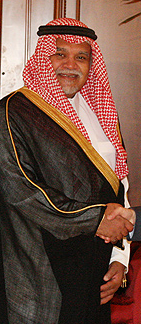
Prince Bandar bin Sultan
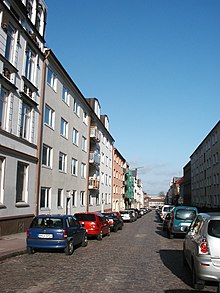
Marienstraße 54 in Hamburg, residence of some of the assassins from 1998 to 2001
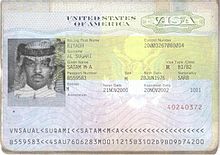
The visa of Satam al-Suqami found in front of the World Trade Center...
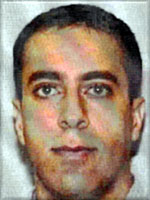
Ziad Jarrah (26), Pilot of flight UA93

Hani Handschur (29), Pilot of flight AA77

Marwan al-Shehhi (23), Pilot of flight UA175

Mohammed Atta (33), pilot of flight AA11
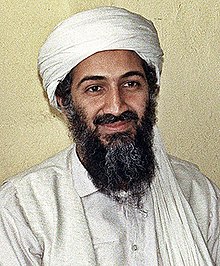
Al-Qaeda founder Osama bin Laden
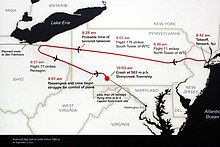
Procedure of UA Flight 93
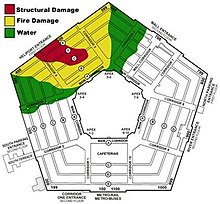
Damage to the Pentagon
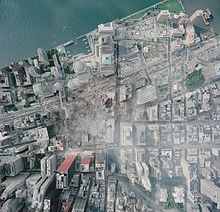
High resolution aerial view of Ground Zero
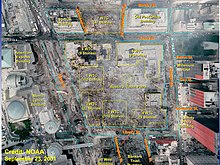
Ground Zero with the former locations of the WTC buildings
.png)
WTC area with the impact sites
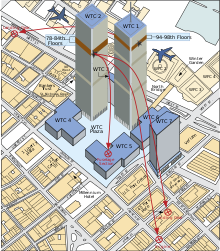
WTC with location of the impacts and sites of debris of the two airplanes
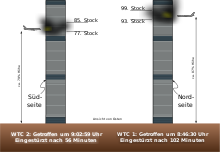
Twin Towers with location of aircraft impactsLeft : WTC 2 (South Tower) Right: WTC 1 (North Tower)
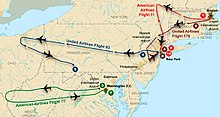
Flight paths of the four hijacked passenger planes

17:20: Last WTC 7 collapses
.jpg)
Firefighting at WTC 6

Survivors after the collapse
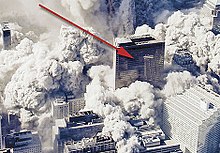
10:28 a.m.: WTC 1 collapses in a dust cloud of ash and debris, with WTC 7 later collapsing in the middle.
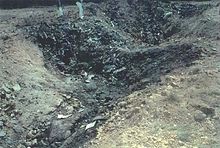
10:03: UA93 crashes near Shanksville. Shot of the impact crater
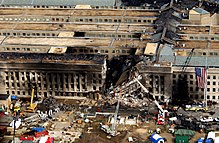
Impact damage at the Pentagon (photo taken on September 14, 2001)
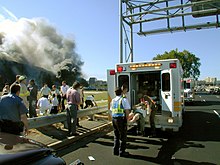
Rescue work at the Pentagon
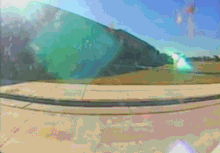
9:37: AA77 flies into the Pentagon
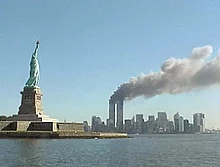
The images of the burning Twin Towers that have manifested themselves in the collective memory...
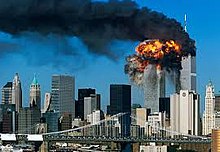
9:03: Impact of UA 175 with WTC 2...

Play media file WTC 1 collapses (minute 18:10)
.webm.jpg)
Play media file WTC 2 collapses (at minute 15:09)
.webm.jpg)
Play media file UA 175 hits WTC 2 (at minute 3:14)
Political consequences
Initial reactions (USA)
Andrew Card, then White House Chief of Staff, informed U.S. President George W. Bush at a student lecture in Sarasota, Florida, around 9:00 a.m. local time of the first attack on the WTC, and shortly thereafter of the second: "A second plane has hit the second tower. America is under attack." Bush continued the school meeting on camera for another seven minutes. He made an initial statement after briefly conferring with his staff and then flew to various U.S. Air Force bases on the presidential plane Air Force One. Around 7:00 p.m., after a stopover, he arrived in Washington, D.C. and the White House. At 8:30 p.m., George W. Bush delivered a nationally televised address to the American nation.
In the first days after the attacks, Muslims, Arabs or Arab-looking and turban-wearing people, often Sikhs, were insulted, attacked, threatened and some murdered in the US. There have also been arson attacks on Islamic institutions. US President Bush subsequently visited a mosque on 17 September 2001, condemned the attacks, distinguished Islam from terror and called for tolerance towards Muslim US citizens.
Initial reactions (worldwide)
In the days that followed, many people around the world commemorated the victims of the attacks with a minute's silence and funeral services. Leading politicians from many countries condemned the attacks and sent letters of condolence to the USA.
German President Johannes Rau declared on the evening of September 11, 2001: "Hate destroys the world and hate destroys people. That is what it is about everywhere...: To resist hate and to make room for charity. Those who do not hate also say no to violence. Those who say no to violence make the lives of our children possible." On September 14, 2001, at a solidarity demonstration in Berlin attended by some 200,000 people, Rau said, "Hate must not seduce us to hate. Hate blinds. [...] The best protection against terror, violence and war is a just international order." This was taken as a contrast to the "unlimited solidarity" and rejection of war declared earlier by Chancellor Gerhard Schröder.
A funeral service was held at St. Paul's Cathedral in London. The Guards outside Buckingham Palace played the US national anthem.
War in Afghanistan
→ Main article: War in Afghanistan since 2001
On 12 September 2001, the UN Security Council unanimously condemned the attacks with Resolution 1368 and allowed the USA to use military self-defence. For the first time in its existence, NATO declared an "alliance emergency": A belligerent attack on the territory of a NATO member state had occurred, which, according to Article 5 of the NATO Treaty, was to be considered an attack on all contracting parties and required their military assistance.
On 20 September 2001, in an extraordinary government statement to the US Congress, US President Bush first declared the US's gratitude for international solidarity and singled out "loyal friend" Great Britain for special mention. He then named the international terrorist network al-Qaeda under Osama bin Laden as the organization responsible for the attacks, to which all evidence pointed, and demanded bin Laden's immediate extradition by the Taliban regime in Afghanistan. Otherwise, he announced a "war on terror." In doing so, he emphasized the difference between the Afghan people and their government, whose human rights abuses he criticized. Further, he made an ultimate call on all nations to choose to support the U.S. "Either you're on our side or you're on the terrorists' side." He then differentiated Islam from terror in the name of Allah: He respected the faith of Muslims; al-Qaeda was in blasphemous opposition to it. He called attacks on Muslims in the U.S. "un-American." The speech was greeted with bipartisan support; Bush's approval ratings in the US rose to over 90 percent at times.
While Secretary of Defense Donald Rumsfeld wanted to attack Afghanistan as soon as possible, Secretary of State Colin Powell managed to get an ultimatum to the Taliban to extradite Bin Laden beforehand. Negotiations on extradition, however, ended inconclusively. On October 7, 2001, the U.S. Army began bombing Taliban positions and infrastructure in Afghanistan. The USA initially excluded its own ground troops. On November 13, the Northern Alliance, which was allied with the Taliban, captured Kabul without a fight; Kunduz was occupied on November 25, and Kandahar on December 7. By the end of the year, the regime under Mullah Omar had been overthrown. Bin Laden escaped at the Battle of Tora Bora in December and spent the period until probably 2003 in a remote village in Afghanistan's Kunar province.
From December 2001 onwards, a number of European states, including the Federal Republic of Germany with Bundeswehr soldiers, supported the additional security and reconstruction missions OEF and ISAF.
War in Iraq
→ Main article: Iraq war and justification of the Iraq war
In September 2002, Bush derived from the war on terror the right of the USA to launch pre-emptive strikes (the so-called Bush Doctrine) and justified the Iraq war, which had been sought since the end of September 2001, on the one hand with an alleged collaboration of the dictator Saddam Hussein with Al-Qaida, and on the other hand with his alleged disposal of weapons of mass destruction, which he could and wanted to use against the USA and US troops stationed in Saudi Arabia. Germany, France, Russia and China rejected this doctrine, the US war justifications and their participation in the Iraq war. The UN Security Council denied the US the legitimacy of the Iraq War in February 2003. The U.S. government then formed a "coalition of the willing," including some NATO countries, and launched the Iraq War in March 2003 without a UN mandate. It led to the overthrow of Saddam Hussein, followed by years of terrorist attacks by a new, Iraqi branch of al-Qaeda and other groups in Iraq.
International Relations
In 2003, the political scientist Jochen Hippler classified the US wars in Afghanistan and Iraq not only as a reaction to the attacks, but also as a continuation of a unilateral US foreign policy. He argued that the US had used its position as the only remaining superpower after the Cold War to implement a neoconservative programme that had been in place since around 1995, to disempower "rogue states" and hostile regimes, to expand US power in the Middle East and Central Asia, and to strengthen its global leadership role. This view is also held by scholars in the US, such as George Leaman.
The terrorist attacks had initially greatly facilitated this policy, but the pretextual overthrow of the Ba'athist regime had enormously exacerbated violence and terror in Iraq, deepened the rift between Western-backed Arab dictatorships and their populations, and thus increased instability in the Middle East region. At the same time, it has ended international solidarity with the US, damaged the authority of the UN and international law and the West's relationship with the Islamic world, created a rift between the US and Europe and between supporting and rejecting states in the EU, and thus made a unified EU foreign and military policy more difficult.
The wars waged by the US in the aftermath of the attacks and the neoconservative project of "benevolent imperialism" to spread democracy and a market economy in the Middle East are now seen as imperial overstretch and are no longer pursued by the US.
Domestic politics (USA)
The attacks led to an unprecedented expansion of presidential power and a de facto abolition of the separation of powers in the United States. This was based, in addition to the role of the president as the constitutional head of the executive branch and commander-in-chief of the American armed forces, primarily on the theory of the unitary executive. According to this theory, the executive is legally superior to the legislative and judicial branches, and his ability to perform his constitutional duty and protect the American people may not be impeded by decisions of Congress: Accordingly, he could decide autonomously whether and how to apply the laws. Congress followed Bush in this interpretation of the Constitution; only the U.S.Supreme Court has insisted in several decisions since 2004 that principles of the rule of law such as habeas corpus and the separation of powers remain valid.
Under the term Disaster Preparedness, the U.S. government increased funding, personnel, authority, and tasks for disaster response, airport security, and aviation security. A state of emergency was declared on 14 September 2001.
In October 2001, Vice President Dick Cheney directed eight domestic intelligence agencies to circumvent an existing 1970s law that prohibited dragnet and dragnet searches without a warrant. On 26. October 2001, the USA PATRIOT Act went into effect, defining "domestic terrorism" as influencing the government through intimidation or coercion and allowing U.S. federal agencies to make sweeping intrusions into civil liberties for anti-terror investigations: Such as the surveillance of suspected persons without a warrant, the secret interception of telephone calls, storage of connection data and spying on e-mail contacts, the collection of personal information from insurance companies, financial institutions and employers, the detention and deportation of suspected terrorist aliens without information and judicial review of suspicious circumstances and with aggravated detention review rights. Subsequently, by 2003, over 5,000 foreigners, mostly young male Muslims with contacts in Arab states, had been arrested, 531 of them deported, some held for up to eight months, but none of them charged. Although the Supreme Court had declared some of these provisions unconstitutional since 2004, in March 2006 the U.S. Congress extended 14 of 16 provisions of the USA PATRIOT Act indefinitely. Bush broke the law's requirement to provide Congress with full information on the implementation of the measures - in total, 263 security agencies have been newly established or reorganised in the USA, in addition to the central Department of Homeland Security with 170,000 employees; 1,200 state organisations and 1,931 private companies have since been involved in danger prevention.
Similar laws were passed by other Western countries, tightening entry requirements and expanding surveillance of individuals. The Federal Republic of Germany reintroduced dragnet searches and leniency programmes from the 1970s fight against the RAF and passed two "anti-terror packages". Draft laws introducing preventive detention (2004), telecommunications surveillance (2005), permission to shoot down hijacked aircraft and preventive dragnet searches (2006), secret online searches of private computers (2008) and data retention (2010) were each declared unconstitutional by the Federal Constitutional Court.
Domestic policy (EU)
The European Council decided on 21 September 2001 to combat terrorism within the territory of the European Union (EU) as a matter of priority. By Common Position 931 of 27 December 2001, the EU Member States unanimously adopted additional measures to combat terrorism. In particular, Regulation (EC) No 2580/2001 adopted a single list of persons, groups and entities to whom financial sanctions (freezing of funds and economic resources and a ban on the making available of funds and economic resources) may be applied for the purpose of combating and preventing terrorism. With this and the so-called EU terror list, the EU complied with UN Resolution 1373.
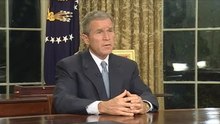
Play media file George W. Bush's speech to the nation on the evening of September 11.
.ogv.jpg)
Play media file George W. Bush's first reaction a few minutes after the attacks on the World Trade Center (Sarasota on September 11, 2001 at 9:30 a.m.)

Questions and Answers
Q: What were the September 11 attacks?
A: The September 11 attacks, also known as 9/11, were four terrorist attacks against the United States of America that occurred on the morning of Tuesday, September 11th, 2001.
Q: How many people died in the attacks?
A: Almost 3,000 people died in the attacks, including 19 attackers.
Q: Who was responsible for carrying out the attack?
A: The Islamic terrorist group al-Qaeda was responsible for carrying out the attack.
Q: What buildings were attacked?
A: The Twin Towers and part of the Pentagon in New York City and Arlington, Virginia were attacked. A fourth plane crashed in an empty field near Shanksville, Pennsylvania before it could reach its intended target in Washington D.C., which was either the White House or U.S Capitol Building.
Q: How much damage did these attacks cause?
A: These attacks caused more than $10 billion dollars worth of damage to infrastructure.
Q: What event is commonly attributed to beginning War on Terrorism?
A: The September 11 Attacks are commonly attributed as being what made War on Terrorism begin.
Search within the encyclopedia